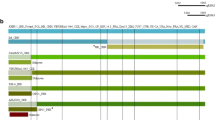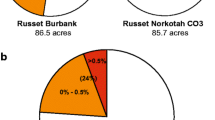Summary
Potato leaf roll virus (PLRV) was usually better transmitted byMyzus persicae from source plants kept during the pre-acquisition period at 12°C than from those kept at 26°C. Significantly more plants became infected when PLRV was acquired or inoculated at 26°C than at 12°C. The effect of temperature during the acquisition feeding period was found to be greater than that of temperature during the inoculation feeding period. PLRV was most frequently transmitted when it was both acquired and inoculated at 26°C.
Zusammenfassung
Der Einfluss der Temperatur auf die Übertragung des Kartoffel-Blattrollvirus (PLRV) durchMyzus persicae wurde in drei Perioden vor der Infektion der Pflanzen mit diesem Virus ermittelt: Vegetationsperiode vor Aufnahme durch die Virusquellen, Periode während der Virusaufnahme und der Inokulationsperiode. Die Untersuchungen wurden in temperaturkonstanten Kammern und im Gewächshaus mit Pflanzen der Kartoffelsorte Osa als Quelle mit ausgewählten PLRV-Isolaten durchgeführt. Das Virus wurde aufPhysalis floridana und Kartoffelsorten unterschiedlicher Anfälligkeit übertragen.
Die Häufigkeit der PLRV-Übertragung durchM. persicae sank mit ansteigender Temperatur, zu welcher die Quellenpflanzen in der Periode vor der Virusaufnahme aufwuchsen (Abb. 2 und 3), obwohl dieser Effekt ausgeschaltet werden konnte, wenn das Virus durch die Blattläuse bei höherer Temperatur aufgenommen wurde (Abb. 2).
Die Häufigkeit der PLRV-Übertragung durch Blattläuse war nach einer Aufnahmeperiode bei 26°C signifikant grösser als bei 12°C (Abb. 2 bis 4). Der Einfluss höherer Temperatur könnte stark genug sein, die Unterschiede in der PLRV-Übertragung durch den Einfluss auf die Quellenpflanzen in der Vor-Aufnahmezeit zu eliminieren oder zu vermindern (Abb. 2). Ähnliches zeigte sich bei zunehmendem Alter der Quellenpflanzen (Abb. 1).
Eindeutig mehr Pflanzen wurden infiziert, wenn PLRV bei 26°C anstatt 12°C inokuliert wurde (Abb. 3 und 4).
Der Einfluss der Temperatur war in der Aufnahmeperiode grösser als in der Inokulationsperiode.
Eine signifikant grössere Population vonP. floridana und/oder Kartoffelpflanzen wurden infiziert, wenn PLRV durchM. persicae bei 26°C aufgenommen und inokuliert wurde (Abb. 3 und 4). Darüberhinaus war der Einfluss höherer Temperatur, während beider Aufnahmeperioden angewendet, günstiger für visuelle und serologische (ELISA) Differenzierung der resistenten und anfälligen Kartoffeln, gemessen an der Häufigkeit infizierter Pflanzen (Abb. 4).
Résumé
L'influence de la température sur la transmission du virus de l'Enroulement de la pomme de terre (VEPT) parMyzus persicae a été déterminée à trois périodes précédant l'infection des plantes par ce virus: période de végétation des plantes sources de virus avant acquisition (pré-acquisition), période d'acquisition, période d'inoculation. Les recherches ont été réalisées dans des salles à température contrôlée et en serre: des pommes de terre du cultivar Osa, infectées par des isolats sélectionnés de VEPT ont été utilisées comme plantes sources. Le virus a été transmis àPhysalis floridana et à des cultivars de pomme de terre de différentes sensibilités à l'infection par le VEPT.
La fréquence de transmission du VEPT parM. persicae décroît avec l'augmentation de la température à laquelle les plantes sources de virus ont été cultivées lors de la période de pré-acquisition (Figs 2 et 3), bien que cet effet ait pu être éliminé quand le virus a été prélevé par les pucerons à température plus élevée (Fig. 2).
La fréquence de transmission du VEPT par les pucerons a été significativement plus grande après une période d'acquisition à 26° qu'à 12°C (Figs 2–4). L'effet de la température la plus élevée a pu être suffisamment fort pour supprimer ou réduire les différences de transmission du VEPT causées par l'effet de la température sur les plantes sources lors de la période de pré-acquisition (Fig. 2) ou par l'augmentation de l'âge des plantes sources (Fig. 1).
Un nombre significativement plus grand de plantes a été infecté quand le VEPT était inoculé à 26°C qu'à 12°C (Figs 3 et 4).
L'effet de la température s'est avéré avoir une importance plus grande pendant la période d'acquisition que pendant la période d'inoculation.
Une proportion significativement plus élevée deP. floridana et/ou de plants de pomme de terre a été infectée quand le VEPT était à la fois acquis et inoculé parM. persicae à 26°C (Figs 3 et 4). De plus, une température plus élevée appliquée pendant les deux périodes d'alimentation des pucerons s'est montrée plus favorable pour différencier visuellement et sérologiquement (ELISA) les pommes de terre résistantes, modérément résistantes et sensibles, lorsqu'on se base sur la fréquence des plantes infectées (Fig. 4).
Similar content being viewed by others
References
Daniel, G. & M. Munzert, 1982. Nachweis des Blattrollvirus an sekundärinfizierten Kartoffelpflanzen mit ELISA.Nachrichtenblatt des Deutschen Pflanzenschutzdienstes 34: 51–54.
Erickson, R. O. & F. J. Michelini, 1957. The plastochron index.American Journal of Botany 44: 297–305.
Gill, C. C., 1969. Cyclical transmissibility of barley yellow dwarf virus from oats with increasing age of infection.Phytopathology 59: 23–28.
Robert, Y. & J. Rouzé-Jouan, 1971. Premières observations sur le rôle de la température au moment de la transmission de l'Enroulement parAulacorthum solani Kltb.,Macrosiphum euphorbiae Thomas etMyzus persicae Sulz.Potato Research 14: 154–157.
Syller, J., 1981. Importance of the age of potato plants and leaves in transmission of some isolates of potato leaf roll virus byMyzus persicae (Sulz.). In: Plant virology. Proceedings of the 9th Conference of the Czechoslovak Plant Virologists, (Brno, 1981): 169–172.
Syller, J., 1985. Comparison of some isolates of potato leaf roll virus in Poland.Phytopathologische Zeitschrift 113: 17–23.
Tamada, T. & B. D. Harrison, 1981. Quantitative studies on the uptake and retention of potato leafroll virus by aphids in laboratory and field conditions.Annals of Applied Biology 98: 261–276.
Tanaka, S. & H. Shiota, 1970. Latent period of potato leafroll virus in the green peach aphid (Myzus persicae Sulz.).Annals of the Phytopathological Society of Japan 36: 106–111.
Webb, R. E., 1956. Relation of temperature to transmission of the potato leafroll virus.Phytopathology 46: 470.
Webb, R. E. & E. S. Schultz, 1958. On the nature of resistance to the potato leafroll virus.American Potato Journal 35: 728.
Author information
Authors and Affiliations
Rights and permissions
About this article
Cite this article
Syller, J. The influence of temperature on transmission of potato leaf roll virus byMyzus persicae Sulz. Potato Res 30, 47–58 (1987). https://doi.org/10.1007/BF02357683
Accepted:
Issue Date:
DOI: https://doi.org/10.1007/BF02357683




